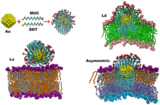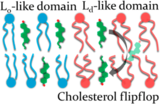Membrane Biophysics
Physical principles governing biological membranes.
Cells are surrounded by membranes, thin sheets made up of two layers of molecules that separate the inside from the cell from its environment. These molecules, lipids, have water-loving headgroups and oily tails so that the membrane has an oil-like interior. Biological membranes contain a vast variety of proteins that are responsible for contact between the cell and the outside world: they transmit signals, transport nutrients, and other molecules, and maintain the right conditions for the cell. Lipids also play an important role in these processes.
Among other things, they allow direct transport of hydrophobic molecules through lipids, can change the physical properties of the membrane, and modulate the properties of membrane proteins. Using fast computers and a description of how atoms interact with each other, it is possible to calculate in atomic detail how lipids, water, and proteins move in time. In recent years, this molecular dynamics simulation method has been a very powerful method to solve problems in the area of lipids and proteins. This project is aimed at developing and improving computational models of the lipid component of membranes and their interactions with small molecules (drugs, anaesthetics, biopollutants). Such models can be used to better understand the properties of lipids, their function in biological membranes, the bioavailability of drugs, the mechanism of aneasthetics, and for future studies on membrane proteins.
Unlocking the Mysteries of Membrane Cells
Cholesterol is a crucial component of mammalian cellular membranes, making up a significant portion (25-40 mol%) of the plasma membrane. Eukaryotic cells are thought to contain lipid rafts, which are small, dynamic domains enriched in cholesterol, sphingomyelin, and membrane proteins. Lipid rafts could mediate cell signaling, lipid and protein trafficking, and pathogen entry. How these molecules interact is paramount for understanding eukaryotic life, and they have been implicated in many important diseases, including cancers, diabetes, Alzheimer’s disease, HIV entry, and atherosclerosis.
In the Biocomputing group, we perform Molecular Dynamics (MD) computer simulations to probe the interaction between cholesterol and phospholipids at sub-nanoscale resolution. MD simulations involve two basic steps: determining the energy of the system and the resulting force on each atom, then updating the positions based on Newton’s equations of motion.
These steps are repeated millions of times and require the use of powerful supercomputers to produce a short (100s of nanoseconds) movie or trajectory of the molecules’ thermal fluctuations. From the trajectory, researchers can determine macroscopic properties through statistical mechanics and compare them to experimentally observable properties. MD simulations provide a novel view of membrane systems, with atomistic details of the dynamic behavior of single molecules - generating structural, mechanistic, kinetic and thermodynamic data.
Related publications

Effects of Lipid Ordering and Leaflet Asymmetry
Atomistic Simulations on Interactions between Amphiphilic Janus Nanoparticles and Lipid Bilayers: Effects of Lipid Ordering and Leaflet Asymmetry


